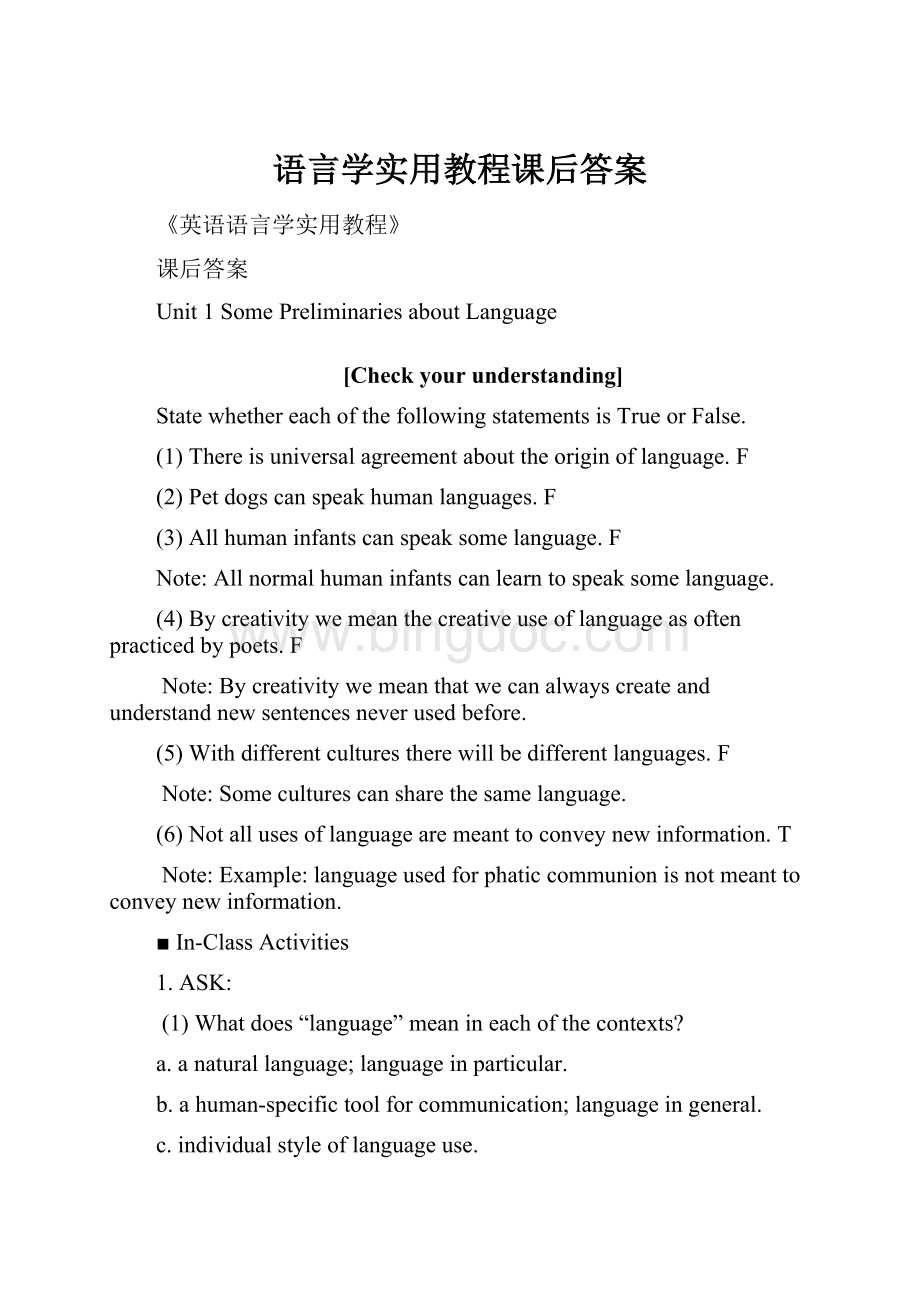语言学实用教程课后答案Word下载.docx
《语言学实用教程课后答案Word下载.docx》由会员分享,可在线阅读,更多相关《语言学实用教程课后答案Word下载.docx(97页珍藏版)》请在冰点文库上搜索。

(6)Notallusesoflanguagearemeanttoconveynewinformation.T
Example:
languageusedforphaticcommunionisnotmeanttoconveynewinformation.
■In-ClassActivities
1.ASK:
(1)Whatdoes“language”meanineachofthecontexts?
a.anaturallanguage;
languageinparticular.
b.ahuman-specifictoolforcommunication;
languageingeneral.
c.individualstyleoflanguageuse.
d.ametaphoricalwayofreferringtobees’systemofcommunication.
(2)Isthereanyothercontextinwhichtheuseofthewordmeanssomethingelse?
Yes.Example:
languageforthecomputerlikeC+
2.ASK:
(1)Whatiftherewerenolanguage?
Omit.
(2)Whatiftherewereonlyonelanguagetheworldover?
(3)WhatcanwelearnfromthisBiblestory?
Languageispowerfulasatoolofhumancommunication.
3.ASK:
(1)Doyouthinkthetwostatementsareequallyprobable,andifnot,whynot?
(a)ismorelikelythan(b),becausethewordasthebasicunitofmeaningthatcanoccurindependentlyinlanguageisfiniteinnumber,whereasthesentenceascomposedofwords,thoughalmostinfiniteinnumber,ismadepossiblebyourknowledgeofvocabularyandgrammar.Wecanalwaysproduceandunderstandsentencesthatwenevercomeacrossbefore.Inthatsense,nosentenceisreallynew.
(2)Inwhatcontextdowemakethesecondstatement?
Whenwefocusourattentiononthemeaningofasentenceorwhenweareconcernedwiththeformofasentenceasfoundinalanguageclass.
4.ASK:
(1)ArethereonomatopoeicwordsinChinese?
Yes.e.g.“哗啦”、“扑通”、“喀嚓”.
(2)Doestheexistenceofonomatopoeicwordsoverthrowtheclaimthatlanguageisarbitrary?
No.Onomatopoeicwordsaccountforaverylimitedpercentageinthevocabularyofalanguage.
5.ASK:
(1)Canonereallyinventalanguageofone’sown?
No.
(2)Ifnot,why?
Alanguagecomesintobeingandusebyconventionoragreementamongitsspeakers.
6.ASK:
(1)Isthereanybasicflawinthisexperiment?
Theprocessisnotstrictlycontrolled.Theremayhavebeensomecoincidence.Thesamplesizeistoosmallfortheexperimenttobevalid.
(2)Doyouthinkwereallycananswerthequestionaboutthebeginningoflanguage?
No,atleastinthepresentconditionwhere/whenwecannotperformexperimentsonthehumanbrain,thekeyorganofspeech.
7.ASK:
(1)Canyouidentifythemostlikelyorder(fromleasttomostadvanced)ofthesesamples?
C→B→A
(2)Whatfeaturesineachchild’sutterancescanyouuseasevidencetosupportyourordering?
ChildA:
goodsyntaxexceptforimproperquestionform.
ChildB:
visibledevelopmentofsyntax;
overgeneralization
ChildC:
Notmuchsyntax;
two-wordutterances;
telegraphicsentences(sentencesthatcontainonlycontentwordsbutlackfunctionwords)
8.ASK:
(1)Itisoftenassumedthatchildrenimitateadultsinthecourseoflanguageacquisition.Canimitationaccountfortheaboveproductiononthepartofthechild?
Notwholly.Thereiscounterevidenceagainsttheassumption,liketheovergeneralization“go-ed”for“went”.
(2)Whatdistinguishesthechild’sproductionfromthatoftheadult?
Overgeneralizationof“-ed”forthepasttenseasshownby“holded”.
9.ASK:
(1)Howdoadultsreinforcetheprocessofchildren’sacquisitionasexemplifiedhere?
Theyuseexplicitcorrection.
(2)Dochildrenknowwhattheyaredoingwrongly?
Notexactly.
(3)Dotheadultssucceedintheirreinforcement?
Notalways,atleast.
(4)Howshouldwetreatthe“mistakes”thatchildrenmakewhileacquiringtheirmothertongue?
Wemayignorethemsometimes,althoughsomeamountofreinforcementmayturnouttobehelpful.
10.ASK:
(1)Dochildrenlearnthroughstructuredorsimplifiedinput,assuggested?
Notalways.Thereisevidenceforbothsides.
(2)Canyouoffersomeexamplesillustrating,representingthewayadultstalktoinfants?
Omit.
Mothereseischaracterizedbyshortersentences,higherpitch,exaggeratedintonation,higherproportionofcontentwordstofunctionwords,simplesyntax,moreinterrogativesandimperatives,morerepetitions.Yetitisnotsyntacticallysimpler.Rather,itmayincludesyntacticallycomplexsentencessuchasquestions:
Doyouwantyourjuicenow?
Embeddedsentences:
Mommythinksyoushouldsleepnow.Imperatives:
Patthedoggently!
Negativeswithtagquestions:
Wedon’twanttohurthim,dowe?
Indeed,itisfortunatethatmothereseisnotsyntacticallyrestricted.Ifitwere,childrenmightnothavesufficientinformationtoextracttherulesoftheirlanguage.
11.ASK
(1)Whatmeasuresdoyousuggestforprotectingdialectsaswellaslanguages?
(2)Doyouthinkthatsomedaypeopleallovertheworldwillspeakonlyonelanguage,orsomedaynodialectwillexist?
Omit.
12.ASK:
Arethereanyuniversalsthatyouthinkalllanguagessharebutarenotmentionedhere?
E.g.Alllanguageshaveinternalstructures.
Alllanguageshavenumericals.
■Exercises
Task3:
StudyQuestions
1.Whatdoyouthinkisessentialtotheemergenceoflanguage?
Theexistenceofsocialactivities;
theneedtoexpressdiverseideas,emotions,etc.;
theneedtocommunicateideastodistantplaces;
etc.
2.Canourpetslearnhumanlanguages?
Whyorwhynot?
No.Theyaregeneticallynotendowedwiththecapacity.
3.Whatroledoesbodylanguageplayinlanguagecommunication?
4.Naturallyoccurring“experiments”withso-called“wolf-children”,“bear-children”,“Mowgli”or“monkey-children”andothersuchferalyoungstershavebeenwidelyreportedforhundredsofyears.Noneofthesechildrencouldspeakorunderstandspeechand,indeed,mosteffortstoteachthemlanguageendedinfailure.Howwouldyouaccountforthefailure?
Thelanguageacquisitiondevicehastobetriggeredbeforeacertainage(thatofpuberty).Sufficientexposetoalanguageenvironmentattherighttimeisessentialtolanguageacquisition.
5.ThefollowingaresomeinstancesofusingEnglishforcommunication.WhatspecificfunctiondoeseachuseofEnglishserveinthefollowingpictures?
Informative(intheformofcommanding)
Directive(Advertisingintheformofrequesting)
Directive(Persuadingintheformofthreatening)
Directive(Recruiting)
6.Iconicityoflanguageisanaspectoflanguagewhereformechoesmeaning.Onomatopoeia,alsoknownas“soundsymbolism”,isonetypeoficonicity.Someresearchershavefoundotherevidenceoficonicity.Forexample,wordsbeginningwiththesoundcombinationsl-inEnglishoftenhaveanunpleasantsense,asinslithering,slimy,slugs.Herearesomequestions:
a.Isthe“unpleasant”senseactuallytrueofall,orevenmost,wordsbeginningwithsl-inEnglish?
No.e.g.slight.
b.Arethereanyothersoundsorsoundcombinationsthatyouassociatewithparticularmeanings?
Gliding:
slide,slip,slippery;
Rolling:
tumble,crumble,stumble
c.Howaboutthevowelsoundsinwordsthatidentifynear-to-speakerconcepts(this,near,here)versusfar-from-speakerconcepts(that,far,there)?
Whatisthedifference?
IsitageneralpatterndistinguishingtermsforthingsthatarenearversusfarinEnglish?
WhataboutthecaseinChinese?
Frontvowelsfornear-speakerconcepts;
centralorbackvowelsforfar-from-speakerconcepts.ThereseemstobeasimilarkindofpatterninChinese.C.f.近jin/远yuan;
这zhe/那na
7.Inmanyoftheworld’slanguagesthereareso-callednurserynamesforparents.InEnglish,forexample,correspondingtothewordmotheristhenurserynamemama,andforfatheronefindsdadaandpapa.Thereisremarkablesimilarityacrossdifferentlanguagesintheformofthesenurserynamesforparents.Forexample,inChineseandNavajomacorrespondstoEnglishmama.Whydoyouthinkthatthisisthecase?
Bilabialsarelearnedandproducedfirstbecausetheyaretheeasiest.
8.
a.Whataresomeofthechangeswhichappeartohavetakenplaceinthechild’sabilitytouseEnglishduringthatperiod?
Likethebasicallyproperuseofinterrogativesandthecorrectuseofinflection.
b.Whatdothesechangessuggestabouttheorderoflanguageacquisition?
Completesentencesareacquiredlaterthanellipticalones.Inflectionisacquiredatalatestage.
Unit2TheSoundsofEnglish
1.[i:
]and[i]areallophonesofthesamephoneme.F
2.NotallEnglishphonemeshaveallophones.T
//and/j/occurinonesinglepositionandthereforedonothaveallophones.
3.Thesamesetofvowelsisusedinalllanguages.F
4.Allsyllablesmustcontainatleastonevowel.F
Somesyllablesmaycontainnovowels.Theymay,instead,employsomesyllabicconsonant,asinpeopleandmuscle.
5.ThemarkingofwordstressisarbitraryforthemostpartinEnglish.F
6.Englishisatonelanguage.F
Chineseisatonelanguage.
(1)Whatisthephoneticenvironmentof[t]in[pit]?
[i_#]
(2)Arethefollowingpairsofwordsminimalpairs?
(a)deskvs.taskNo.
(b)leavevs.LeakYes.(li:
vvs.li:
k)
2.ASK